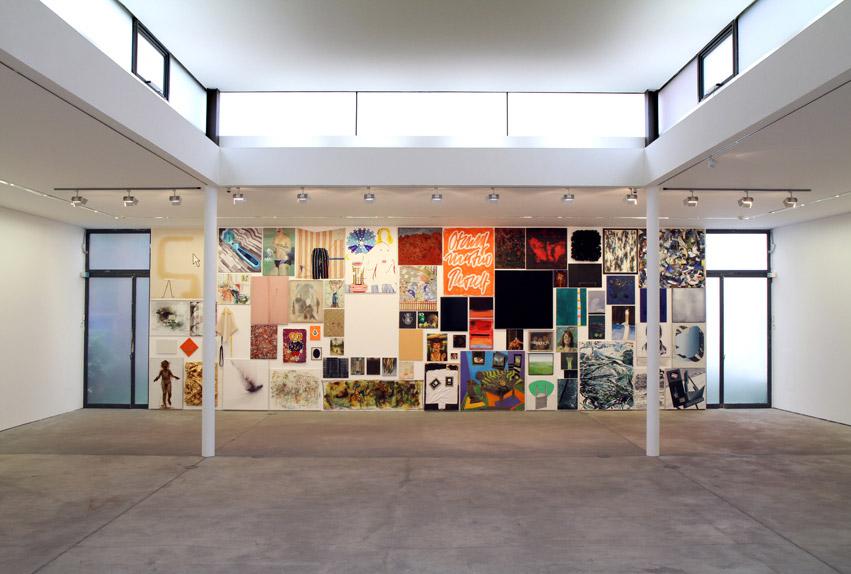“Painting Forever!”—a super-exhibition spread across four Berlin institutional galleries—is the central showcase of Berlin Art Week, although its exclamatory first principles are perhaps a foregone conclusion. The so-called critical resurgence of interest in painting is, by now, something that has been going on for more than a decade; is anyone still claiming the irrelevancy of painting? Surely no one doubts any longer that painting is forever; can’t we all just get back to enjoying paintings without subjecting them to constant existential exegesis?
The shows at the four galleries—the KW Institute for Contemporary Art, the Berlinische Galerie, the Neue Nationalgalerie and the Deutsche Bank Kunsthalle—add very little to any contemporary discourse about painting. What is exceptional about the collection of exhibitions is that they are entirely Berlin-focused: everyone shown (including Berlin-based Canadians Shannon Bool and Shannon Finley) either works or has worked in the city. As a result, the shows read as an attempt to address the Berlin painting scene.
Nevertheless, each show is its own discretely curated entity, and the respective public didactic material doesn’t encourage intercontextual readings. But for the most part, this disparateness doesn’t do any harm; by and large, they’re competently assembled shows (with one exception, which I’ll get to later) that offer a great deal of formal subtlety and visual pleasure.
Franz Ackermann’s “Hills and Doubts” takes over the entrance hall to the Berlinische Galerie with an enormous mural: a bravado fireworks display of colour and form, immersive and dizzying, an explosive rethinking of the landscape genre.
The Deutsche Bank Kunsthalle’s “To Paint is to Love Again” has three women painters—Antje Majewski, Katrin Plavčak and Giovanna Sarti—positioned in response to the 1950s, 60s and 70s work of Jeanne Mammen, who originally came to prominence in the Weimar era. There is some astounding painting in the show (Plavčak’s deft touch and incisive criticality making her a particular standout), although the connection between Mammen and these women sometimes gets a little cloudy.
The Neue Nationalgalerie’s “BubeDameKönigAss” fares the best of the shows. Four painters of the same generation and locale—Martin Eder, Michael Kunze, Anselm Reyle and Thomas Scheibitz—are displayed together for the purpose of precisely noting how divergent their practices are: Eder’s psychosexual realism, Kunze’s teeming literary allusiveness, Reyle’s garish metallic constructions and Scheibitz’s soft plastic geometricism.
In that sense, “BubeDameKönigAss” has the most to say about the state of contemporary painting; that these four men, who share a material, geographic and generational frame of reference, arrive at four vastly different processes implies limitless formal and theoretical possibilities inherent in painting: an open field, whose primal playfulness makes it all the more rigorous and difficult. If “Painting Forever!” is at all celebratory, “BubeDameKönigAss” is its centrepiece.
By contrast, KW’s “Keilrahmen” (“Stretcher Frame”) almost undoes the whole affair.
“Keilrahmen” is appalling: 75 paintings by 75 artists, all crammed together on the far wall of the KW’s ground floor hall, with no clear attribution. The result is a jumble, a chaotic goulash in which every work—no matter how bold or graphic—gets lost in an indiscriminate soup of visual disorganization.
The didactic material for “Keilrahmen” makes reference to the Hermitage Museum, and to salon-style hanging. Anyone with any kind of art-historical memory knows that even in the wall-to-wall display strategies of the19th century, large frames separated paintings from each other, so that images could have their own lebensraum. Curator Ellen Blumenstein has forgotten that basic fact, and heaped paintings atop one another, with scant centimetres separating unframed works, while the rest of the cavernous gallery remains yawningly empty.
Blumenstein’s curatorial statement is likewise a confused, piecemeal affair. Presented in numbered-note form, she begins by talking about painting materials and ends up at an allusive, confused, jargon-laced theoretical discussion about frames that ends with the following sentence: “Within the framework of Painting Forever!, a cooperation between four Berlin institutions that the Berlin Senate suggested and provided with decisive financial support for, the KW exhibition […] must be seen in a very different framework.”
To me, this reads very much like an abdication, and an excuse—“I didn’t want to play with these other people, I didn’t want to play this game, they made me”—with Blumenstein implying that KW’s interest in its own exhibition is forced by the municipal government’s political and financial insistence.
In effect, the show at KW is so poorly conceived and displayed, and its curatorial intent so dismissive, it evidences nothing so much as an utter contempt for painting. Ironically, this only underscores the importance of the over-emphatic titling of “Painting Forever!”: there are indeed curators and institutions who, in fact, wonder why it still exists at all.









